LX-5025 - Accelerated Acid Etch for Auto
Technical Bulletins
Posted 2023
Last Updated 2023
LX-5025
Abstract
Many attempts have been made in the past to develop a test that can predict the acid etch resistance of automotive clearcoats. Methods such as the Gradient Bar and Acid Spot are just two examples of the numerous laboratory methods used in industry today. No laboratory method currently in use correlates well with the results observed in the field. Past attempts to use accelerated weathering to replicate acid etch results have also failed to correlate. This paper examines a new automotive acid etch test procedure developed jointly by BASF Corporation and Q-Lab Corporation. Extensive environmental data was collected on composition and acidity of rainfall, frequency and duration of rainfall events, air and specimen temperatures. The critical test parameters identified include acidic solution, temperature, humidity, UV spectrum, radiant heating of the specimen and specimen orientation. Drawing on the field data, a simulated acid rain solution was developed, along with an exposure test cycle. An accelerated weathering device was modified to create a new model to accommodate the exposure requirements. The newly developed procedure, called the BASF Accelerated Acid Test, shows excellent correlation with field etch results. In addition to outlining the recent development work, this paper also sets the expectations for the future availability of the protocol to industry at large.
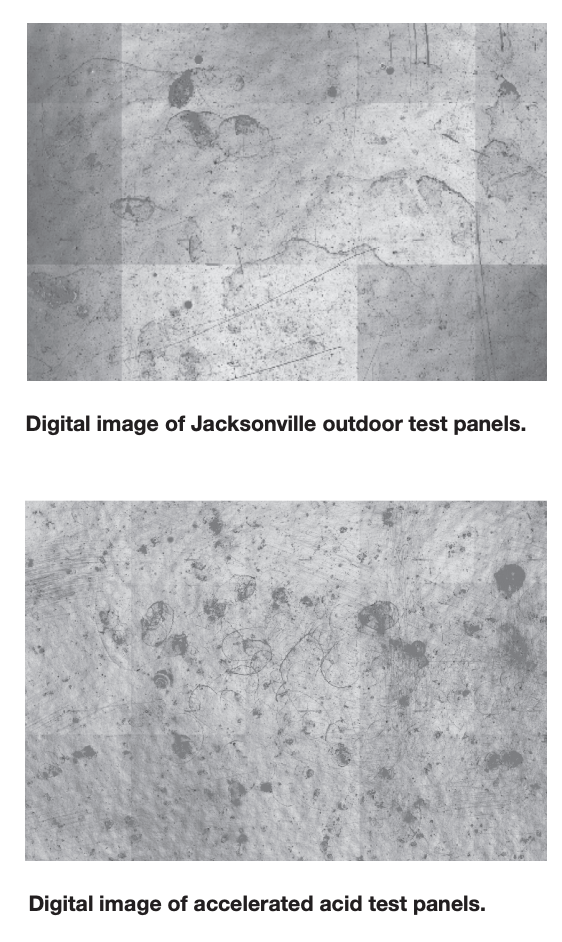
Background
In the 1980s, damage to automotive coatings from acid rain occurences became a problem. Both dealerships and buyers complained about the ring type or “water spot” etches that were formed from the acid catalyzed hydrolysis that occurred in areas where acid rain occurred and temperatures were high. Etches are formed when material is lost from the surface of the coating. This material is lost as a result of acid catalyzed hydrolysis of the chemical bonds within the coating. When enough bonds are broken, polymer molecules or fragments become detached from the rest of the coating, and are washed away. The lost material is greatest at the edge of water droplets where the acid concentrates during evaporation. This leads to the familiar ring or “water spot” pattern. Most successful work on improving the acid etch resistance of automotive coatings has focused on reformulation to reduce or eliminate the acid sensitive sites within the polymer network. Most automotive coatings are comprised of a highly pigmented color coat (or basecoat), which is covered with a transparent clearcoat. Blount Island Exposures. Summertime on Blount Island in Jacksonville, Florida was, and continues to be, one of the most severe locations in North America for the conditions that cause acid etch. As a result, this location is the site for numerous annual field tests to assess the performance of automotive coatings for acid etching resistance. Varying numbers of hoods, panels and fascia are placed in Jacksonville each year by Automotive OEMs and their suppliers. These hoods, panels and fascia vary in size and shape, but are mostly black to create the worst case scenario for etch testing. The Items are exposed in a variety of ways, but are typically tested between 0 and 5 degrees horizontal. The typical testing period is approximately 14 weeks, from June to September of each year. The test specimens are rated for etch damage at varying times throughout the 14 week period using a visual method of evaluation, with standard panels used as a guide. While the Blount Island exposures have the benefit of real-world testing, there are significant limitations to the current procedure in terms of product development. In addition to the inconvenience of a single location and narrow time frame for testing, the results of this annual test vary like the weather. Accelerated Acid Etch. Many attempts have been made to develop laboratory techniques that predict etch resistance of automotive clearcoats. There are a number of methods currently used in the industry, such as the Gradient Bar Test or the Acid Spot Test. None of these tests have included all of the field components that contribute to the etching of automotive clearcoats (humidity, UV light, specimen orientation and acidic solution).
Development of Current Procedure
BASF recognized the need for a realistic laboratory accelerated acid etch test procedure, and began to quantify the critical elements. Many of the critical test parameters could be reproduced in existing xenon arc test chambers Since the 1950s, xenon arc testers have been used to test the weatherability of coatings. These devices have attained significant popularity because they utilize a light source which, when properly filtered, provides an excellent simulation of the full spectrum of sunlight. Traditionally, these devices have a xenon light placed in the center of the chamber, with the test specimens mounted vertically on a framework. The framework revolves around the light source, like a carousel. This mechanism is often called a “rotating drum” style tester, and is available in many models, and from several manufacturers. An example is shown in Figure 1. Unfortunately, the vertical specimen mounting system means that any liquid sprayed onto the specimen tends to rapidly run off. Recently, Q-Lab Corporation developed and introduced the Q-Sun Xenon Test Chamber. As shown in Figure 2, the Q-Sun has xenon lamps positioned at the top of the exposure chamber, with the test parts and panels underneath the lamps. Test specimens are positioned in a near-horizontal orientation. This has several design advantages. Specifically, any liquid sprayed onto the specimens tends to remain for an extended time. Instead of quickly running off, as it does on the older rotating drum style xenon tester, it slowly dries in place. BASF scientists recognized that this flat-array xenon would be particularly useful for reproducing the acid rain effects seen on horizontal specimens in Jacksonville. Because of Q-Lab’s experience in weathering science, correlation studies and tester design, BASF partnered with Q-Lab to embark on a joint research project to develop a realistic accelerated acid etch test procedure.
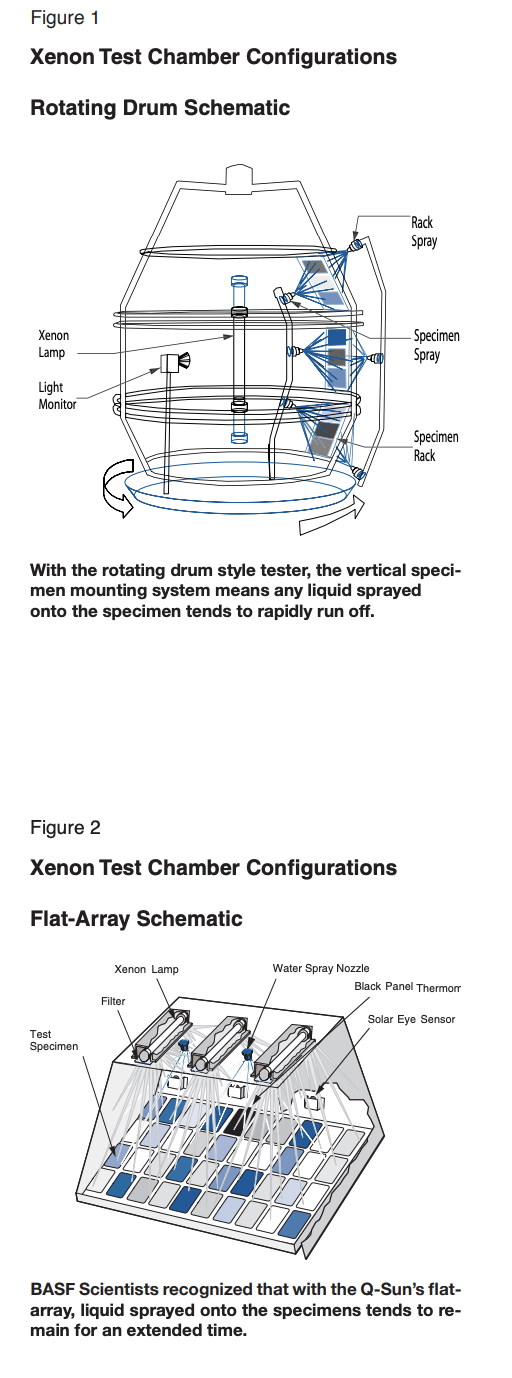
Quantifying the Exposure Environment
BASF has been monitoring the exposure conditions at the Jacksonville, Florida exposure site for a number of years. Based on that data, the following are the critical environmental conditions which were considered in the development of the new BASF Accelerated Acid Test procedure. Temperature. Early on, BASF recognized the importance of the effect of temperature on the Jacksonville field exposure results. Consequently, temperature parameters were quantified by taking real time measurements of the actual specimens exposed in Jacksonville, which are shown in Table 1. In 1993, thermocouple measurements produced specimen temperatures as high as 80˚C. In 2002, Jacksonville pyrometer measurements of actual parts and test panels (under field conditions) show the maximum specimen temperatures to be approximately 72˚C.

As a result of this data, 80˚C was chosen as the target Uninsulated Black Panel 2 temperature for the light exposure step of the Q-Sun test. Rainfall. BASF scientists identified the necessity to use a simulated rain solution with a specific pH and chemical composition known to produce etch in Jacksonville. Field observations indicated that trace rainfall of less than 0.25 cm (< 0.1 inch) and low cloud cover, are the conditions most responsible for producing acid etch in Jacksonville. Studies determined that lower pH rainfalls are the most responsible for producing etch (e.g., 3.49 pH collected in Jacksonville in 1989). The Jacksonville weather data in Table 2 indicates that between June and August, there are an average of 10-15 days of this type every year.

Humidity and Wet Time. BASF research indicated a need to maintain a Relative Humidity that was consistent with Jacksonville’s natural exposure environment. This would best mimic the prolonged dry-off seen in the field. Jacksonville weather data shows that the Relative Humidity averages approximately 80% during the summer months (June-August). Time of wetness (TOW) research in Florida and other locations indicates that test specimens are wet more than 50% of the time, and that the source of this wetness is dew (Grossman, 1978). Field observations in Jacksonville confirmed this, because on most summer evenings, dew formed on the parts and panels. Typically, the dew was still in place the following morning. Therefore, in the lab simulation, a series of pure water sprays during the Q-Sun's dark step are used to simulate the evening dew. At the same time, a high humidity of 80% is maintained throughout the test to simulate the summer conditions in Jacksonville. Specimen Orientation. Panels and parts exposed outdoors in Jacksonville are positioned at the horizontal or near-horizontal orientation angles that give severe etch effect. Typically, the most severe etching is observed at a 0 to 5 degree exposure. To reproduce the most severe field exposure conditions, the accelerated test in the Q-Sun required the chamber to be modified in order to orient the test specimens at 0 degrees. This is a modification from the normal Q-Sun exposure angle of 10 degrees. UV Light. Q-Panel’s experience dictated that for the best correlation to outdoor results, the lab specimens should be exposed to UV light with a similar Spectral Power Distribution (SPD) and intensity to that which is seen in the field. Q-Panel research on sunlight spectrum shows that, although the spectrum of daylight changes minute by minute throughout the day (see Figure 3), the peak noon summer sunlight solar maximum is approximately 0.68 W/m2 /nm @340 nm. Q-Panel’s measurements are essentially in agreement with CIE 85, Table 4, and with the new SMART2 spectra currently proposed by ASTM Committee G03.

Some older automotive test methods, such as SAE J1960, use an “Extended UV” xenon spectrum to accelerate the coating degradation. This spectrum has the disadvantage of producing short wavelength UV below the solar cut-on point of 295 nm. Experience has taught us that this spectra, shown in Figure 4, can cause unnatural results for some coatings. Consequently, more recent test protocols, such as SAE J2527, allow for a more realistic spectrum by specifying the Daylight Filter described in ASTM G155. This is the same spectra specified in ISO 4892-2 and ISO 11341. The Daylight Filter spectrum, shown in Figure 5, was chosen for the new BASF Accelerated Acid Test procedure because of its close match with natural sunlight.
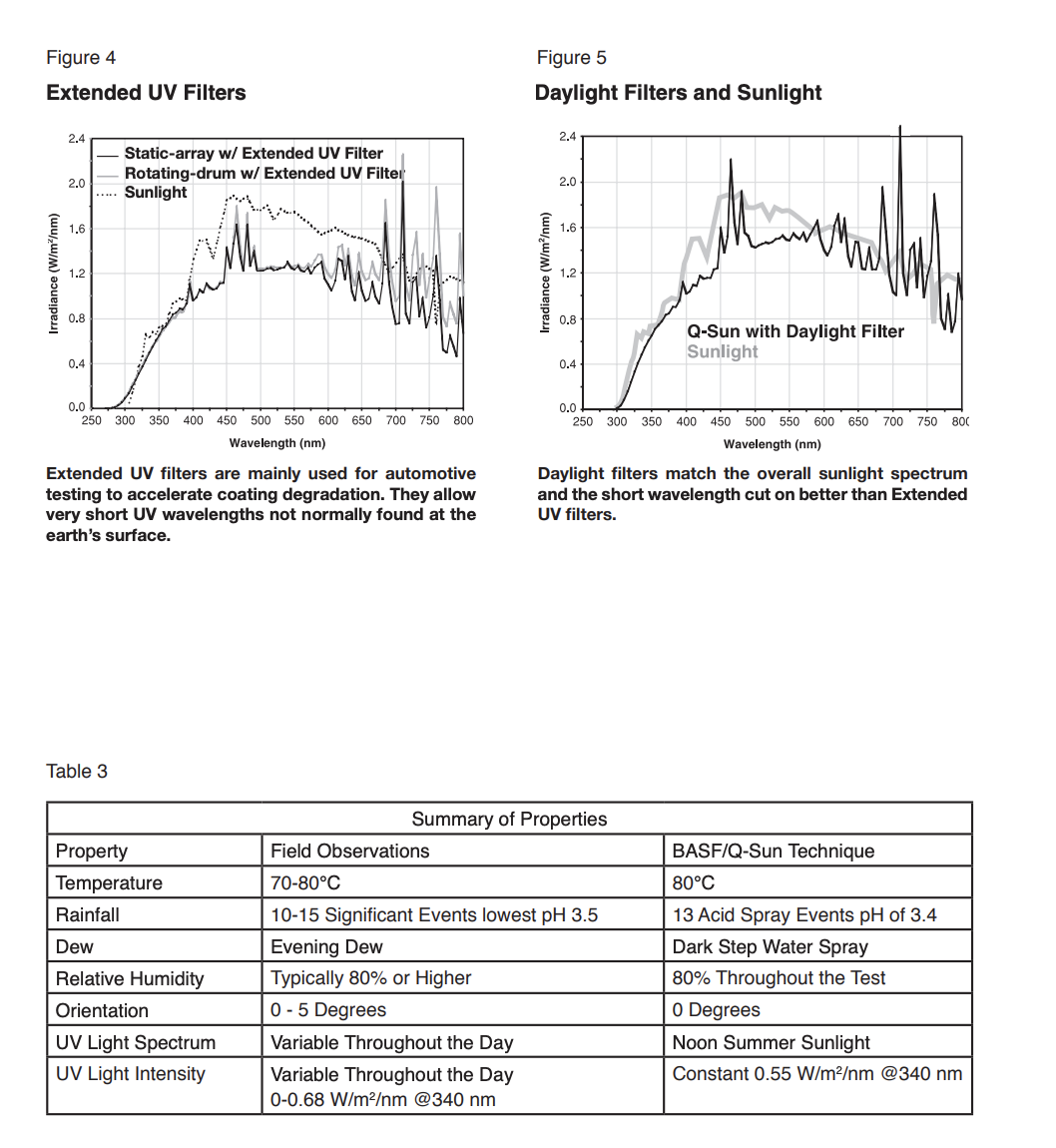
Experimental Development
BASF developed a simulated acid rain solution which was based on the observed acid rain chemistry in Jacksonville. BASF also provided Q-Lab an initial set of test specimens coated with 4 types of clearcoat systems. The Q-Sun Xenon Test Chamber was modified into a new model to incorporate the features dictated by field observations. A 0˚ specimen mounting plane and a dual spray system were added. The dual spray system can be programmed to automatically spray pure DI water and a solution in addition to and separate from the DI water, such as a simulated acid rain solution. Using the modified Q-Sun test chamber, Q-Lab experimented with various test cycles, including 100% light, with intermittent acid spray. Table 3 on the previous page gives a summary of the properties of field observations and the accelerated technique. Q-Lab determined that a cycle with both a light and a dark time exposure gave better correlation to the outdoor etch results from Jacksonville. The volume and frequency of acid spray was adjusted to best simulate the outdoor results. After some Edisonian Research, an optimized exposure cycle was developed, which is shown in Table 4. After the cycle was determined, the test specimens were exposed in the Q-Sun and evaluated at intervals of 200, 300, 400, 500, 600, and 700 hours.
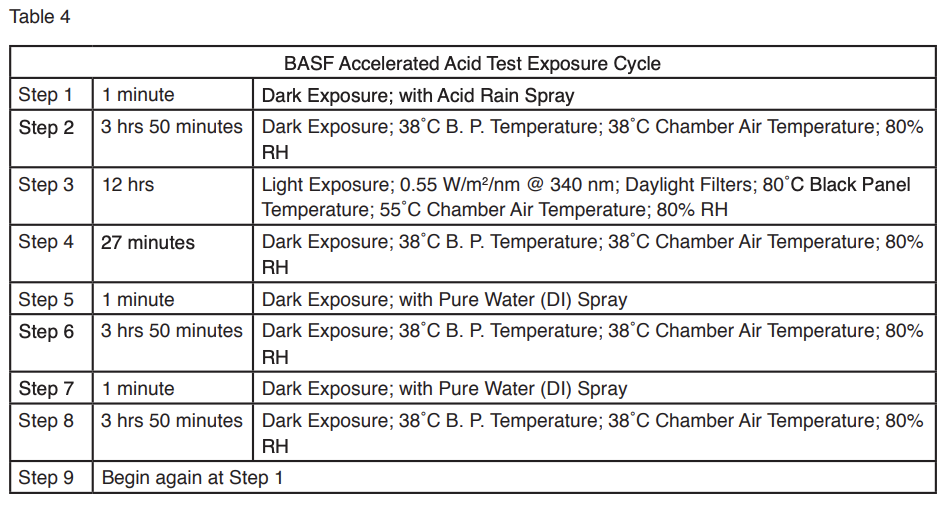
Acid Etch Evaluation Procedure
The evaluation of acid damage was performed visually, and the test specimen were rated on a scale from 0 (best) to 10 (worst). A summary of the rating scale is given in Table 5.


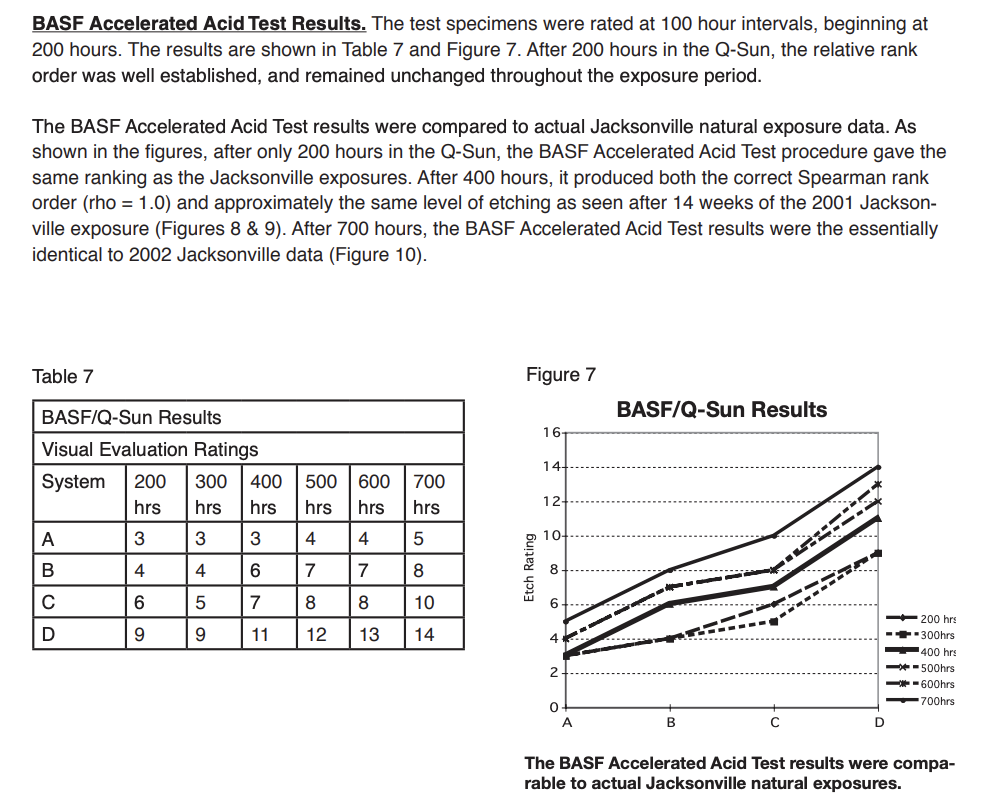
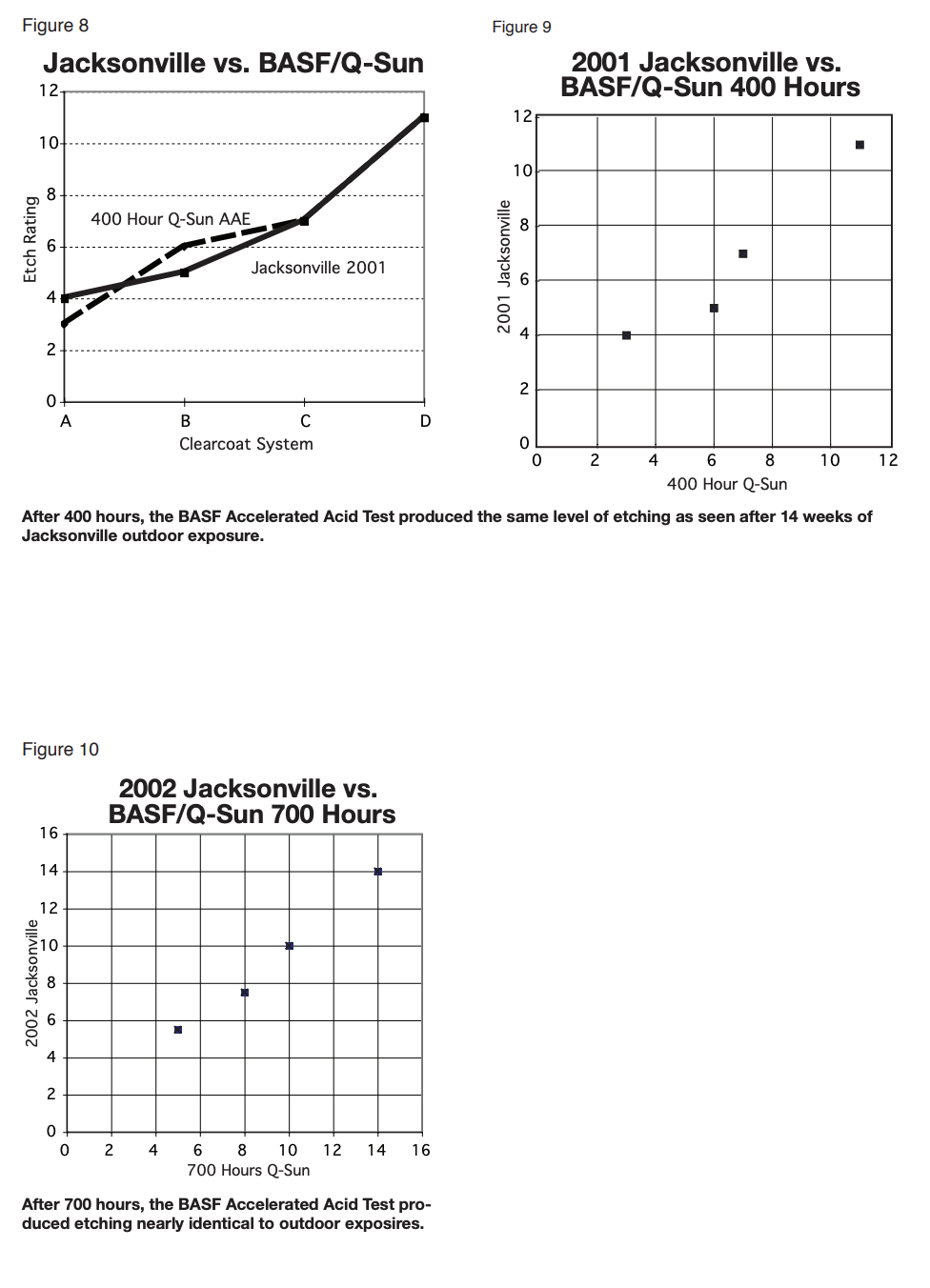
Expanded Testing
Because of the excellent results, the test was expanded to include more clearcoat systems for which Jacksonville data was already available. To establish a benchmark, the Jacksonville 2001 and 2002 data were compared using both Pearson and Spearman correlation methods. For data of this type, the authors believe that Pearson’s method is more useful. The data sets exhibited a Pearson’s correlation coefficient of 0.88 and a Spearman rank order coefficient of 0.72. The same systems were exposed for 420 hours to the BASF Accelerated Acid Test procedure. The Q-Sun results agreed with the 2001 Jacksonville results with an Pearson’s correlation of 0.90 and a Spearman’s rank order coefficient of 0.80. When the BASF Accelerated Acid Test ratings were compared to the average of the 2001 and 2002 Jacksonville results, the correlation was even better. Pearson R2 = 0.93 and Spearman rho = 0.80. In short, the BASF Accelerated Acid Test results agreed with Jacksonville as well as, or better than, Jacksonville agreed with itself.
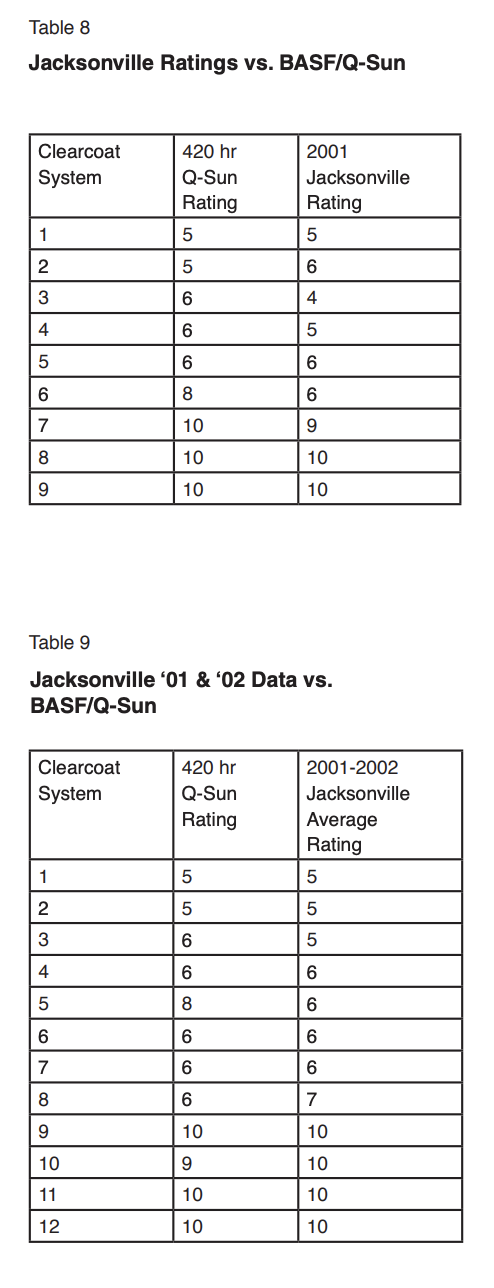
Summary and Conclusions
A new BASF Accelerated Acid Test procedure for the Q-Sun was developed jointly by BASF and Q-Lab Corporation. The procedure identified and incorporated all of the known critical test parameters. In order to accomplish this, BASF developed a simulated acid rain solution and Q-Panel modified the Q-Sun Xenon Test Chamber. Correlation between the new procedure and the Jacksonville natural exposures are better than, or equal to, the correlation between Jacksonville's year to year results. The development of the new procedure has a number of significant benefits to industry: 1. It allows for faster development of etch-resistant coatings. As many as 20 iterations per year of formulate/ test/reformulate vs. current 1 iteration per year, as dictated by natural Jacksonville exposures. 2. The relatively pristine condition of specimens tested in the lab allows for the use of digital evaluation of etches. The Jacksonville panels cannot practically use this technique due to scratches, dirt, etc. 3. It is expected that this BASF Accelerated Acid Etch Test can be used to simulate other acid rain environments, where the rain chemistry differs from Jacksonville. 4. The new procedure allows the possibility of consistent monitoring of assembly plant systems for etch as an “early warning system.” 5. Ultimately, because of the new BASF Accelerated Acid Etch Test procedure, there should be fewer acid etch failures in service.